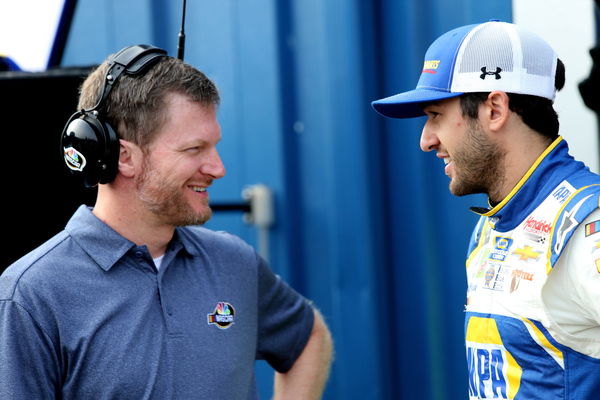
via Getty
BROOKLYN, MI – AUGUST 11: Chase Elliott, driver of the #9 NAPA Auto Parts Chevrolet, speaks with former NASCAR driver, Dale Earnhardt Jr., during practice for the Monster Energy NASCAR Cup Series Consmers Energy 400 at Michigan International Speedway on August 11, 2018 in Brooklyn, Michigan. (Photo by Jerry Markland/Getty Images)

via Getty
BROOKLYN, MI – AUGUST 11: Chase Elliott, driver of the #9 NAPA Auto Parts Chevrolet, speaks with former NASCAR driver, Dale Earnhardt Jr., during practice for the Monster Energy NASCAR Cup Series Consmers Energy 400 at Michigan International Speedway on August 11, 2018 in Brooklyn, Michigan. (Photo by Jerry Markland/Getty Images)
If someone were asked who they thought a superstar in NASCAR was, they’d be ready with at least one answer. Dale Earnhardt Jr would definitely feature, and with the youngest generation of fans, Chase Elliott would be quite popular. But for those who saw the first decade of NASCAR – Fireball Roberts was the man.
ADVERTISEMENT
Article continues below this ad
But still, that doesn’t answer the question – how do you define a driver as a superstar? With Dale Earnhardt Jr and Chase Elliott, there’s a commonality that is easy to find. Both drivers have been immensely popular. Dale Jr won the NMAP’s Most Popular Driver award 15 times, while Elliott has won 5.
A superstar status is largely anointed by the masses, and just like today’s Dale Jr and Elliott, there were similar superstars in the past. Possibly the first of these was Edward Glenn Roberts Jr. Considered by many to be the first superstar of NASCAR history, what makes his achievement even bigger is the fact he never won the Cup Series.
Despite not running enough races to even challenge for a title, journalist Max Muhleman, who covered his whole career, described him as “one of the first guys—maybe the first—to become a big winner by using brains and discipline as well as bravery and extra skill levels.”
“When asphalt tracks arrived, Fireball [Roberts Jr.] recognized the technique was different and adapted to it in a very thoughtful and calculated way, as well as using the skills that take you far in dirt track racing.”
One of the greatest to never have won a seasonal title, Fireball Roberts must really have been a generational talent.
The story behind Fireball Roberts’ nickname
Nicknames in NASCAR generally have great backstories behind them. While most might know the story behind how William Clyde Elliott II became Chase, the story behind Fireball Roberts is relatively unknown. A feature in Autoweek outlines the story behind it.

ADVERTISEMENT
Article continues below this ad
In contention for one of the best nicknames in NASCAR, Roberts Jr’s moniker came as a result of his baseball pitches in childhood. As the story goes, Roberts pitched to his friend, and as soon as his friend caught it – he exclaimed “Fireball!”. That stuck.
Unfortunately, there was a cruel sense of irony too. Roberts died as a result of an accident in a 1964 race in Charlotte’s World 600. His death was a result of his crash which enveloped his car in fire, resulting in the majority of his body charring. He succumbed to those burn injuries and infection within 6 weeks.
But Roberts left a deep imprint of himself wherever he went. Smokey Yunick, a revered innovator and mechanic, called him “the best driver I ever had.” His ex-wife, recalled in a 2000 interview, “What really attracted me to Glenn was his intelligence.”
ADVERTISEMENT
Article continues below this ad
Watch This Story: Who Are the 5 Richest Drivers in Nascar?
“‘I will be a champion.’” is what he told his wife. Unfortunately, that didn’t happen, but NASCAR remembers him.
ADVERTISEMENT
ADVERTISEMENT
ADVERTISEMENT
ADVERTISEMENT

